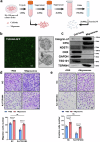Glioblastoma-derived migrasomes promote migration and invasion by releasing PAK4 and LAMA4
- PMID: 39833606
- PMCID: PMC11747271
- DOI: 10.1038/s42003-025-07526-w
Glioblastoma-derived migrasomes promote migration and invasion by releasing PAK4 and LAMA4
Abstract
Almost all high-grade gliomas, particularly glioblastoma (GBM), are highly migratory and aggressive. Migrasomes are organelles produced by highly migratory cells capable of mediating intercellular communication. Thus, GBM cells may produce migrasomes during migration. However, it remains unclear whether migrasomes can influence GBM migration and invasion. In this study, we observed the presence and formation of migrasomes in GBM cells. We found that expression levels of key migrasome formation factor, tetraspanin 4 (TSPAN4), correlated positively with pathological grade and poor prognosis of GBM based on the databases and clinical samples analysis. Subsequently, we knocked down TSPAN4 and found that GBM cell migration and invasion were significantly inhibited due to the reduced formation of migrasomes. We further confirmed that migrasomes are enriched in extracellular matrix (ECM)-related proteins such as p21-activating kinase 4 (PAK4) and laminin alpha 4 (LAMA4). Our experimental results suggest that migrasomes promote GBM cells migration by releasing such proteins into the extracellular space. Overall, we identified migrasomes in GBM and the molecular mechanisms by which they regulate them, providing potential targets for treating GBM.
© 2025. The Author(s).
Conflict of interest statement
Competing interests: The authors declare no competing interests.
Figures






References
-
- Weller, M. et al. Glioma. Nat. Rev. Dis. Prim.1, 15017 (2015). - PubMed
-
- Janjua, T. I. et al. Frontiers in the treatment of glioblastoma: Past, present and emerging. Adv. Drug Deliv. Rev.171, 108–138 (2021). - PubMed
-
- Aldape, K., Zadeh, G., Mansouri, S., Reifenberger, G. & von Deimling, A. Glioblastoma: pathology, molecular mechanisms and markers. Acta Neuropathol.129, 829–848 (2015). - PubMed
MeSH terms
Substances
Grants and funding
LinkOut - more resources
Full Text Sources
Medical
Research Materials

